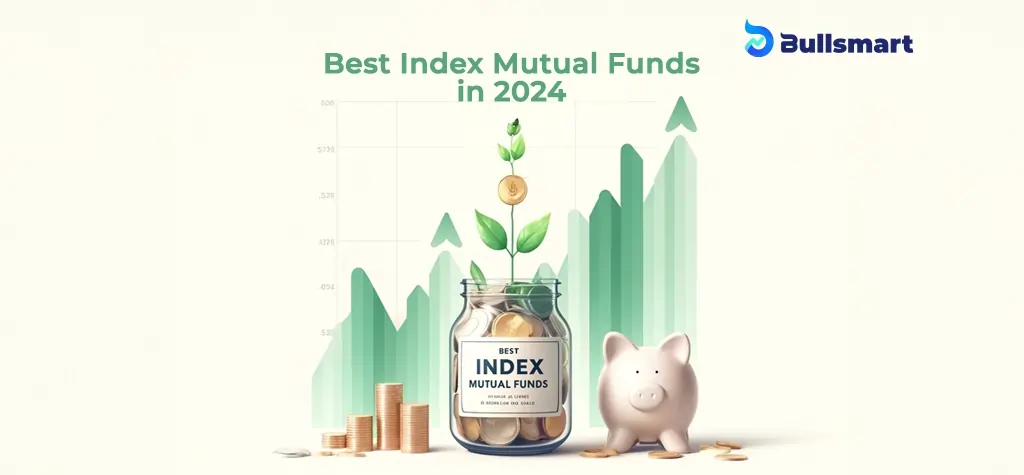The trend for investing in index mutual funds has been on the rise since forever. The low cost and simplicity eventually grab the attention of every investor if they stay invested for long terms. Some index mutual funds have outperformed several actively managed funds and that puts up the big question in front of investors, “are index mutual funds better than active Mutual Funds?”
Let’s explore the pros and cons of index mutual funds in detail and compare them with active funds to get more clarity. Also, this article delves into the list of Best Index Mutual funds in India in 2024.
What are Index Mutual Funds?
The index mutual funds is a type of mutual fund or exchange-traded fund (ETF) created to track the movement and return of a specific financial market index, such as Nifty 50, Sensex, etc. Instead of active management by the fund manager, it follows the underlying index passively by investing in all or representative sampling of the securities included in that index.
Key Characteristics:
- Low Cost: Because these funds are passively managed, their management fees are invariably lower than those of actively managed funds.
- Diversification: Inbuilt diversification by distributing investments across the entire index.
- Consistency: The performance of the fund is benchmarked against an index; therefore, you should expect returns from the market that it represents.
Example:
In the case of a Nifty 50 Index mutual Funds, if you invest in that fund, the fund will try to hold the stocks of the grouping of 50 companies that constitute the Nifty 50 index mutual funds and give returns commensurate with the movement of the index. By investing in a Nifty 50 Index fund, your money will be invested in all 50 stocks in a proportion similar to the constituents of Nifty 50.
Index funds are a great way for investors to expose themselves to the stock market at an extremely low cost with minimal maintenance.
Top Performing Index mutual Funds of 2024
The index funds mentioned in the following table have generated the best returns among all in 2024 till 22nd October 2024.
| Fund Name | AUM (cr) | 2024 Returns till date (YTD) | 1 Year Returns |
| Motilal Oswal Nifty Next 50 Index Fund | 309.25 | 39.39% | 67.26% |
| Motilal Oswal Nifty Microcap 250 Index Fund | 1614.94 | 36.28% | 52.34% |
| Bandhan Nifty 200 Momentum 30 Index Fund | 141.23 | 34.19% | 60.88% |
| Motilal Oswal BSE Enhanced Value Index Fund | 872.92 | 33.64% | 68.23% |
| UTI Nifty 500 Value 50 Index Fund | 499.47 | 32.51% | 66.72% |
Benefits of Investing in Index Mutual Funds
Investing in index funds has several benefits, especially for long-term and hands-off investors. Here are the key advantages:
- Low Cost: Since index funds don’t require active management, they come with lower fees, which helps you keep more of your returns.
- Diversification: These funds spread your investment across a wide range of stocks within an index, reducing risk by not relying on the performance of just a few stocks.
- Market-Level Returns: Index funds track the overall market, so you get returns that mirror how the entire market performs over time.
- No Human Bias: Unlike actively managed funds, index funds simply follow an index, eliminating the potential for errors or biases from fund managers.
- Simplicity: They are easy to manage. You don’t need to constantly monitor them since they automatically follow the index.
How to Choose an Index Mutual Fund?
If you make up your mind to invest in index funds, the next challenge will be the selection of the ideal index fund that suits your appetite. Today, there are a plethora of index funds in the market and each month several new entrants list up to increase the perplexity in choosing the right fund. However, if you keep following pointers into consideration, choosing the right index fund becomes less challenging.
Investment Tenure – If you’re investing for the long term, look at funds that track broader indices like Nifty 50 or Sensex. For short-term goals, you may want to consider more specific or sectoral indices.
Risk tolerance – Different indices come with different risk levels. For example, large-cap indices are less risky compared to small-cap or sector-based indices.
Tracking Error – Choose funds with a low tracking error, which shows how closely the fund mirrors its benchmark index. A lower tracking error indicates that the fund is performing more in line with the index.
Fund Size – Larger funds tend to have better liquidity and lower tracking errors. Look for funds with higher assets under management (AUM).
Historical Performance – While past performance doesn’t guarantee future returns, it’s still useful to look at how consistently the fund has performed over the years.
Suggested Read – Best Momentum Mutual Funds to invest in 2024
Disclaimer: Investments in securities market are subject to market risks, read all the related documents carefully before investing. The securities are quoted as an example and not as a recommendation.

